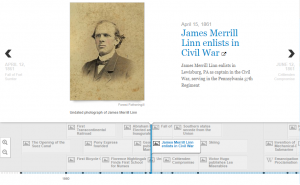Representing complex ideas in a graphical form is such a difficult pursuit that perhaps there can be no perfect finished product, as complex abstract ideas cannot be wholly expressed in visual terms. Grafton examines one of the the oldest and most common ways in which we visualize history, the line. The line as a metaphor is so ubiquitous it appears to be inseparable from our understanding of the passage of time, thus its universality in chronology and graphical representations of history. The line, however important when dealing with the order of things, presents an account of history in a one-dimensional manner. History, as Grafton notes, is filled with relationships, details and digressions impossible to translate into a linear format. Graphical representation gives context to fact, establishes relationships and introduces new information- such as geography- that one might initially overlook. Above providing additional information, graphical representations allows one to easily digest diverse forms of data. Linn’s narrative is closely effected by the events hundreds of miles from his physical location, events like outcomes of distant battles and politics in both Washington and Richmond. The responsiveness of very distant events and the personal life of a single civil war tie in closely with the developments of the 1860s. A message from across the atlantic ocean, thousands of miles from Linn’s position could alter is narrative within a matter of days or hours. One of the major events of the 1860s was the laying of the first transatlantic telegraph cable

. Immense changes were underway during the 1860s that are very evident in Linn’s day-to-day narrative. In fact, the first four events on the TimeMapper follow a common theme; the creation of the first intercontinental railroad, the founding of the Pony Express, the opening of the Suez Canal and the invention of the bicycle.

The world was becoming smaller, information, people and goods could be transported at an unprecedented rate. Countries and continents were interconnected in ways never before seen in history. Thus we immediately see the interweave of the events from the TimeMapper timeline and Linn’s narrative.


 im, and not in the world around him this timeline serves as a useful tool to enlighten us of the global issues and accomplishments of Linn’s time. For example, through this timeline I was able to discover that in 1861 the Fall of Fort Sumter was the battle that began the Civil War. This is important because it gives background to Linn’s experiences during the Civil War, and we can literally see where his diary entries fit in. There are other events that are specifically relevant to Linn and the Civil War such as the secession of the Southern States. Through this timeline I learned of important events that occurred both prior and during the war that Linn failed to discuss or mention in his diary entries.
im, and not in the world around him this timeline serves as a useful tool to enlighten us of the global issues and accomplishments of Linn’s time. For example, through this timeline I was able to discover that in 1861 the Fall of Fort Sumter was the battle that began the Civil War. This is important because it gives background to Linn’s experiences during the Civil War, and we can literally see where his diary entries fit in. There are other events that are specifically relevant to Linn and the Civil War such as the secession of the Southern States. Through this timeline I learned of important events that occurred both prior and during the war that Linn failed to discuss or mention in his diary entries.


 the time when Linn was writing his diary. The creation and study of our completed timeline made me realize a few things. For example, it’s very easy to get wrapped up in a particular set of events. As a result, it can be difficult to recognize, or pay significant mind to, larger events going on around the same time. When reading Linn’s diary, I found myself forgetting that he was writing about events in a small corner of the Civil War. Opening up the scale and comparing his story to the rest of history really put his story into perspective. The scale of a historical graphic really depends on how detailed you make it, represented well by the annals from the 700s in Grafton’s essay.
the time when Linn was writing his diary. The creation and study of our completed timeline made me realize a few things. For example, it’s very easy to get wrapped up in a particular set of events. As a result, it can be difficult to recognize, or pay significant mind to, larger events going on around the same time. When reading Linn’s diary, I found myself forgetting that he was writing about events in a small corner of the Civil War. Opening up the scale and comparing his story to the rest of history really put his story into perspective. The scale of a historical graphic really depends on how detailed you make it, represented well by the annals from the 700s in Grafton’s essay.

